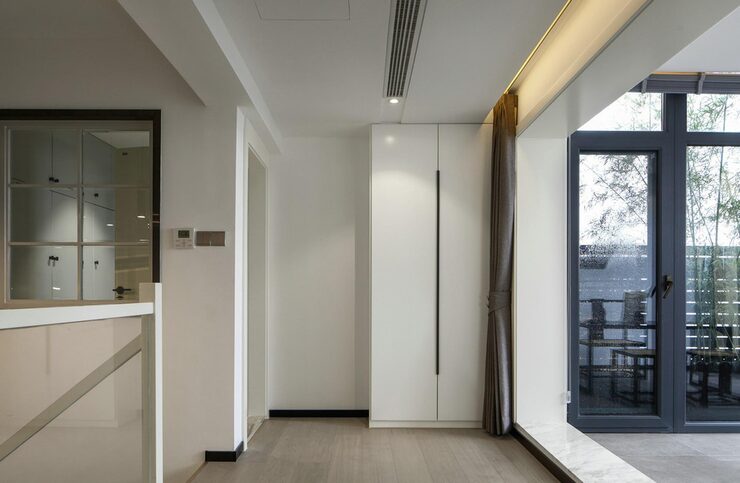When every centimetre counts, design choices shape how a home feels and functions. In smaller apartments, walls sit closer, furniture fits tighter, and floor space feels more valuable. That’s where a pocket door system becomes useful. Unlike swing doors that need open space, pocket doors slide into the wall cavity, creating a more flexible and open layout.
This article explores how this system transforms small spaces, combines form with function, and improves daily living — all without compromising on style.
Understanding the Pocket Door System
The pocket door design hides the door panel inside the wall when opened. The system uses a concealed track and a hollow wall cavity to let the door slide completely out of view. This means the door uses no floor space when open and avoids the issue of swing clearance in tight zones.
This setup creates cleaner sightlines, improves movement flow, and reduces the need to design around a door arc.
How the system works involves three core steps:
- A track is installed within the wall cavity for the door to slide along
- A roller system connects the door to the track, ensuring smooth movement
- The wall is closed and finished with trim, keeping the track hidden
Together, these steps create a system that blends with your wall while remaining fully functional.
Why Small Apartments Need Smarter Solutions?
Space-saving design plays a major role in shaping compact homes. Swing doors often block walking paths or collide with nearby furniture, making simple movement more difficult than it needs to be.
The pocket door system for small spaces eliminates these challenges by allowing the door to disappear into the wall. This change frees up floor space and simplifies how rooms connect.
It also improves flexibility. Rooms once limited by door movement now welcome more layout options, whether for a desk, shelf, or chair.
Blending Style and Structure
Pocket doors solve spatial problems and offer visual appeal. Their clean design lines, absence of swing arcs, and ability to sit flush with the wall give them a modern character. Unlike bulky doorframes or visible hinges, they provide a seamless transition from room to room.
Pocket doors suit a wide range of styles. You can customise them based on your interior’s tone.
Common surface finish options include:
- Painted finishes that match wall colours
- Wooden textures that introduce warmth
- Frosted or patterned glass to allow light through
This versatility means the pocket door doesn’t just fit the space — it enhances it.
Pocket Doors in Daily Use
Homeowners often seek flexible, low-effort ways to separate or connect areas. Pocket doors allow you to shift between open-plan and divided spaces with ease, especially in shared or multi-use apartments.
In daily life, pocket doors work well in many key areas:
- Kitchens, where swing doors disrupt workflow
- Bathrooms or closets, where space is tight
- Bedrooms, where beds sit close to walls
They also suit hybrid spaces where rooms serve more than one role. The door tucks away for open interaction and slides closed for privacy or quiet.
Durability and Strength
Many assume sliding glass doors wear down quickly, but modern systems offer strength and stability. With proper installation and material choice, pocket doors stay smooth over long-term use.
Strong systems include reinforced tracks, durable rollers, and solid door cores. These parts hold shape and weight without bending or slipping.
For long-lasting durability, most setups include:
- Aluminium frames to resist wear
- Dampened closures to reduce impact
- Smooth-glide rollers that prevent jamming
With these elements, pocket doors work reliably even with daily use.
Privacy and Sound Control
Sliding doors can provide privacy when designed well. While not as soundproof as solid walls, pocket doors offer moderate noise reduction and clear room separation.
Thicker doors, foam-filled cores, and tight frame alignment improve sound control. These make a difference in bedrooms, study rooms, or bathrooms where privacy matters.
A system with strong seals and smooth sliding also prevents sound leaks and closes quietly.
Safety and Easy Access
Safety matters, especially in households with children or elderly members. Today’s pocket door systems include soft-close features and smooth guides that prevent injuries caused by slamming or sticking.
Handles vary in design, offering options for ease and accessibility. Even recessed or edge pulls give a firm grip without effort.
Safety-focused designs include:
- Anti-slam tracks that absorb force
- Floor guides to keep the door aligned
- Lightweight cores for easier handling
These features protect both the door and the user.
Comparing Pocket Doors with Traditional Options
To understand the impact of pocket doors, it helps to compare them with traditional door types. The table below outlines the key differences.
| Feature | Pocket Door | Hinged Door |
| Space usage | Slides into the wall | Requires swing clearance |
| Visual style | Sleek and hidden | Bulky and exposed |
| Movement flow | Smooth and unobstructed | Can block walkways |
| Privacy control | Moderate to high | High (solid core) |
| Ease of access | High, no obstruction | May hinder movement |
| Flexibility | Easy in small spaces | Limited in tight zones |
Each feature shows how pocket doors improve flow while meeting everyday needs.
Planning for Installation
Installing a pocket door takes planning. It needs wall space for the cavity, track placement, and depth to hide the door. Not all walls suit this — especially load-bearing ones or those with pipes or wiring.
Builders assess the wall’s structure and plan the cavity width. They then reinforce the frame, install the track system, and finish the wall for smooth sliding.
When done well, the result is clean, seamless, and reliable.
Maintenance Tips
Pocket doors need little upkeep, but regular care helps them run smoothly. Dust, misalignment, or worn rollers can cause jams.
Clean the track and avoid blocking the cavity. Use a soft cloth to wipe parts and check for anything caught inside.
For long-term care:
- Lubricate rollers every few months
- Keep the track clear
- Check handle and guide alignment
These steps help maintain smooth performance.
Smart Home Integration
Some homes now use motorised pocket door systems. With a remote or app, they slide open or shut automatically. Some connect to voice control, adding ease to the system.
This suits users with mobility needs or busy households. Though more advanced, these systems still use the same pocket door framework. Their quiet, consistent motion fits well in modern interiors.
Enhancing Light and Flow
Pocket doors affect light and air. With frosted or clear glass, they let light through while marking space boundaries.
They also guide airflow. In warm climates or cross-ventilated homes, open doors allow full breezes. This boosts comfort without changing window or fan placement. By improving air and light, pocket doors make small homes feel bigger.
Long-Term Value
Pocket doors may cost more upfront, but they add lasting value. They protect nearby items from damage, allow better layouts, and suit growing lifestyles.
As your needs shift, pocket doors remain useful. Open rooms for shared time, or close them for sleep or focus. Their flexibility supports long-term comfort. That makes them a smart investment in small apartments.
Designing with Intention
Design should support how people live. A pocket door shapes space by clearing floor areas, improving flow, and opening sightlines.
In small homes, every choice affects comfort. The pocket door system offers structure and flexibility, helping you move freely while using space wisely. By sliding into the wall, the door works with your layout instead of crowding it.
Final Thoughts
For compact homes, smart design creates ease. The pocket door system for small spaces blends clean style, solid function, and practical use. It saves space without losing comfort or structure. It hides when not in use and works exactly when needed.
Whether separating zones or managing flow, a pocket door adds lasting value. When you choose to slide instead of swing, you open more than a room — you open better living.
FAQ’s
1. What is a pocket door system?
It’s a sliding door that disappears into the wall, saving space and keeping rooms open and stylish.
2. Why are pocket doors good for small apartments?
They free up floor space by eliminating door swings, making compact apartments feel bigger and more functional.
3. Do pocket doors reduce interior style?
No, modern designs offer sleek finishes, glass panels, or wood textures that blend beautifully with different interior styles.
4. Can pocket doors work in bedrooms and bathrooms?
Yes, they provide privacy while saving space, especially useful in tight bedrooms, en-suites, or compact bathroom layouts.



